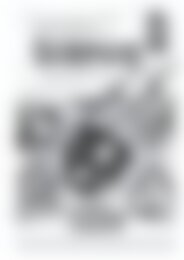PR-6216IRE Reading For Success - Book 1
You also want an ePaper? Increase the reach of your titles
YUMPU automatically turns print PDFs into web optimized ePapers that Google loves.
Phonics<br />
Make a word<br />
Activity sheets<br />
Photocopy page 64. Have pupils cut out the letters at the bottom of the page. Practise identifying the<br />
letters and the corresponding sounds. Then follow the directions below to have pupils make words with<br />
the letters. You may want to practise making the words with the letter cutouts the first time. Then repeat<br />
the directions again while pupils both make the words with the letters and write the words on the<br />
worksheet.<br />
Directions: Use the letters to make the word at. (If pupils have difficulty making the words, segment the<br />
sounds of the words; for example, /a/ … /t/.)<br />
Change the word at to an.<br />
Now, add a letter to change an to ant.<br />
Change one letter to change ant to and.<br />
Change and switch the letters around to change and to Dad.<br />
Change one letter to change Dad to pad.<br />
Change one letter to change pad to pat.<br />
Change one letter to change pat to pan.<br />
Switch the letters around to change pan to tan.<br />
Change one letter to change tan to tap.<br />
See if you can use the letters to make your own word. (Possible words include: tad and nap.)<br />
Draw a letter<br />
Write each letter of the alphabet on the tip of a craft stick, one letter per stick. On the letters that are<br />
vowels, colour the tip of the craft stick red. You may want to colour on the opposite side of the craft stick<br />
from where you wrote the letter. Place the craft stick with the writing side down in a cup. This game can be<br />
played with any number of players; however, fewer than four works best. The first pupil reaches into the<br />
cup and draws one red-tipped craft stick (vowel) and two non-coloured craft stick (consonants) from the<br />
cup. He/she uses the three craft sticks to try to make a<br />
word. <strong>For</strong> example, if the pupil draws the letters a, h<br />
and t the pupil could make the words at and hat. One point<br />
is awarded for each word the pupil is able to make. The next<br />
pupil then takes a turn. Continue until a pupil reaches a<br />
predetermined number of points.<br />
Viewing sample<br />
www.prim-ed.com – Prim-Ed Publishing 63 <strong>Reading</strong> for success


















